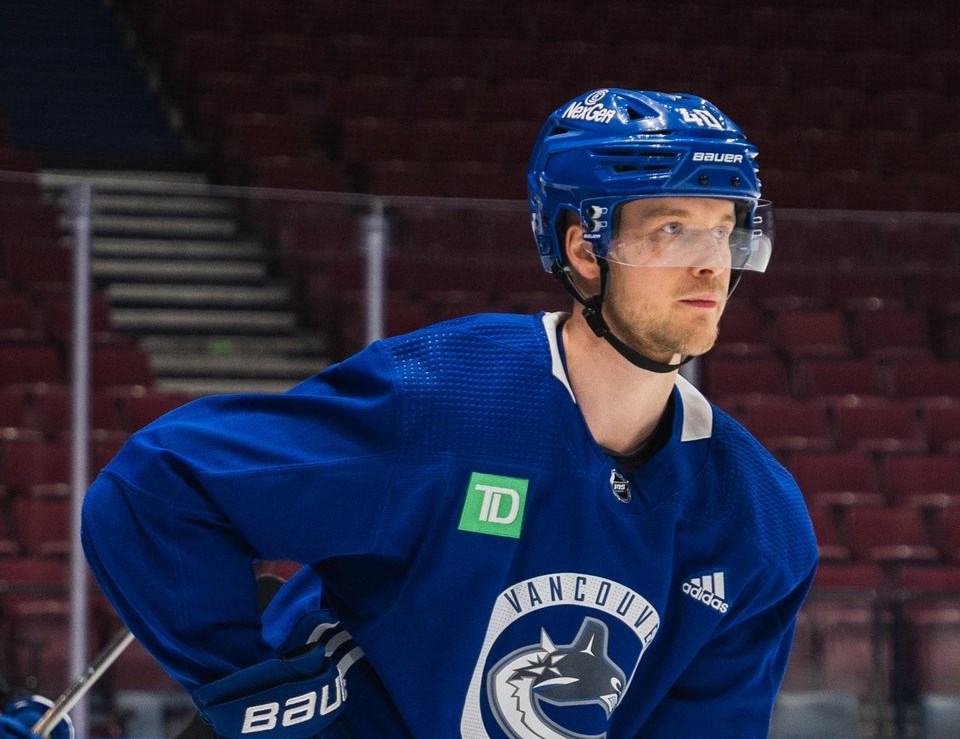Elias Pettersson has always been ruthless about addressing his shortcomings as a player. That’s why he doesn’t have many.
It may be hard to believe, but Pettersson’s shot was not seen as a strength of his game when he was drafted by the Vancouver Canucks. After the draft, however, Pettersson broke down his shot into 12 separate components and relentlessly worked at improving each one until he had one of the hardest shots in the NHL.
“It’s those small techniques that I’m such a nerd about,” said Pettersson to The Athletic in 2020. “It’s just becoming good at things, I always want to be better at whatever I do.”
His shot isn’t the only thing he’s improved in this way, just the most obvious. Heading into this season, there was really only one significant flaw that remained: faceoffs.
"It's something I always wanted to improve on"
As a centre with an excellent two-way game, the only thing that was holding Pettersson back from getting deployed in more defensive situations is that his coaches couldn’t rely on him to consistently win faceoffs.
Heading into the 2023-24 season, Pettersson had a 43.3% faceoff percentage in his career. Among the 128 centres who took at least 2000 faceoffs in that timeframe, Pettersson was ranked 125th.
Pettersson’s career-best faceoff percentage was 45.0% in 2020-21 but he only played 26 games that season. Last year, Pettersson won 44.3% of his faceoffs.
This season, however, Pettersson has taken a huge leap forward. With one game to go in the regular season, Pettersson is at 51.0% in the faceoff circle, firmly above the 50% mark. While he’s still not a faceoff specialist, per se, Pettersson has become far more reliable on draws than he was in the past.
“It’s something I always wanted to improve on,” said Pettersson. “It’s been a long time coming, being over 50. It’s definitely a thing I could improve a lot on and I think I’ve done a good job so far but I still want to raise that number.”
It’s the result of a lot of hard work and identifying exactly what works in the faceoff circle for his game rather than trying to use what works for other players.
“I got some tips along the way but I also had to figure out myself, doing it my way,” said Pettersson. “I’m not the strongest out there, so I just have to use more finesse or be more technical.”
"With the other centremen we have, we're a good faceoff team"
His head coach thinks Pettersson undersold his strength and also pointed out that he’s been more cerebral with how he scouts his opposing centres.
“I think he’s gotten stronger over the summer — that’s helped,” said Rick Tocchet. “I think he’s studied the opposition a little bit more. And I just think with the other centremen we have, we’re a good faceoff team. I think it’s contagious.”
Pettersson's development in the faceoff circle changes the equation for Tocchet, who can now deploy a centre who is 50+% on faceoffs on all four lines. Elias Lindholm has been outstanding on faceoffs since he came to the Canucks via trade, winning 58.7% of his faceoffs. J.T. Miller is not far behind at 56.3%, while Teddy Blueger is at 53.2%.
The Canucks were 18th in faceoff percentage last season. This season, they’re 8th for the whole season but since Lindholm joined the Canucks, they’re first in the NHL, winning 55.5% of their faceoffs.
While faceoffs aren't everything — it's just one puck battle among many in the war for possession — winning a faceoff can be key to winning a game in crucial moments. Heading into the playoffs, the Canucks are the best team in the NHL at that element of the game.
It’s not just Lindholm joining the team that has led to that improvement. Pettersson himself has been a part of that faceoff improvement as he’s only gotten better since the start of the season.
Pettersson has become significantly more consistent on faceoffs
Consider this: over Pettersson’s last 22 games, he has been under 50% in the faceoff circle in just three games. His faceoff percentage across those 22 games is 55.0%.
If we look at a 10-game rolling average of Pettersson’s faceoff percentage throughout the season, we can see what happened: his faceoffs fluctuated wildly through the first three months of the season and hit a low in December, but have been consistently good since January.
In other words, faceoffs are yet another weakness of Pettersson’s game that became a strength through analysis and hard work.
While Miller and Lindholm are the two centres most likely to get sent out to win a crucial faceoff, Pettersson and Blueger are nearly as reliable. That’s why Lindholm and Blueger get paired together on the penalty kill, as do Miller and Pettersson — each of those penalty-killing pairs has two centres who can win a faceoffs.
It also means Tocchet never needs to worry if one of his lines gets stuck on the ice after an icing and has to win a defensive zone faceoff.
“When somebody gets caught out there, we have a good centreman to win the draw,” said Tocchet. “Sometimes, if you don’t have a good centreman, you lose that draw — that’s possession time. It’s a big part of our team, the faceoffs.”
Now Pettersson is a major contributor to that part of the Canucks.



